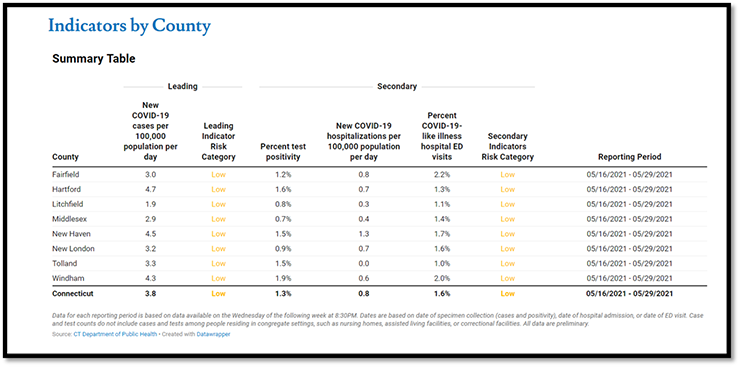Connecticut’s Award-Winning Data Use
July 05, 2021 by Lily Rexing

States regularly collect data from their agencies, but it isn’t often data from separate agencies is leveraged in the context of a widespread public health emergency response. The ability to aggregate disparate information in an accurate, timely way proved more crucial than ever before as states navigated the course of the coronavirus pandemic.
Connecticut’s Open Data Portal (ODP) stood out as instrumental in guiding state decision-makers throughout the past year. To meet the rapidly changing needs of public leaders and constituents, Connecticut needed to scale its existing technology and develop a repeatable framework for interagency collaboration. The state created a new COVID-19 Data Resources Page as a central repository of relevant data for public health information and the state’s response. The page includes data stories, key public health metrics, and a wide variety of resources for residents.
The Departments of Public Health, Social Services, Correction, Developmental Services, and other state agencies all publish COVID-19 data on the ODP. This confluence of relevant information continues to be necessary to meet the public’s demand for timely, accurate data on the pandemic response and recovery. It also provided the Governor with trustworthy and contextualized information for in-depth daily public updates. During the height of the pandemic, the state experienced an eight to ten-times increase in public data consumption. The ODP received more data requests in six months in 2020 than in the first six years the portal was online.
“This solution represents the tremendous effort of state agencies, particularly in public health and education, to present data to state, local, and public stakeholders for critical decision-making, in a contextualized and flexible format,” said Scott Gaul, the state’s chief data officer.
The aggregated public health data was especially instrumental in guiding local education decisionmakers on school learning models. In Connecticut, in-person, hybrid, or remote learning models are chosen at the individual district level. The state developed School Learning Model Indicators to provide access to public health metrics. This allowed local decision-makers determine the safest educational approach using a consistent and up-to-date set of underlying data.

“With the School Learning Model Indicators’ success, data stories are becoming increasingly popular with state agencies and the public,” noted Gaul. “The Departments of Public Health and Education have both added data and stories on COVID-19 cases in schools, school attendance, and participation. These provide an integrated set of data on education and health in schools.”
The State of Connecticut’s open data expansion and enhanced agency collaboration provided public leaders and constituents alike with the ability to make vital decisions in a crisis. The state won a 2021 Tyler Excellence Award for its organizational responsiveness throughout the pandemic because of this work. Leveraging technology for collaboration and insight is replicable for other data programs and holds value even in non-crisis times.